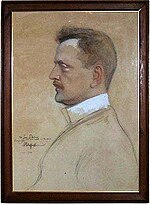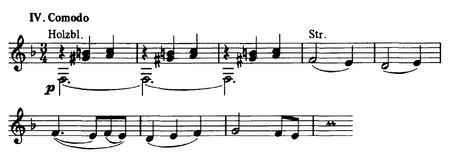| Pelléas et Mélisande | |
|---|---|
| Incidental music by Jean Sibelius | |
 The composer in 1904, by Albert Edelfelt The composer in 1904, by Albert Edelfelt | |
| Catalogue | JS 147 (threatre score) |
| Opus | 46 (concert suite) |
| Composed | 1905 (1905) |
| Performed | 17 March 1905 (1905-03-17) |
| Movements | 10 |
| Scoring | orchestra |

Pelléas et Mélisande (Pelléas och Mélisande), JS 147 is incidental music by Jean Sibelius for Maurice Maeterlinck's 1892 play Pelléas and Mélisande. Sibelius composed in 1905 ten parts, overtures to the five acts and five other movements. It was first performed at the Swedish Theatre in Helsinki on 17 March 1905 to a translation by Bertel Gripenberg, conducted by the composer.
Sibelius later slightly rearranged the music into a nine movement suite, published as Op. 46, which became one of his most popular concert works.
Movements of the suite
The movements were derived from the following numbers:
- At the Castle Gate (Prelude from Act I, scene 1)
- The opening movement of the suite for orchestra is called "At the Castle Gate". The strings introduce an atmospheric, brief theme, which is then restated with help from the woodwind. This introduction is closed by austere chords. This section is familiar to British television viewers as the theme of the world's longest-running TV programme (1957–present), the BBC's The Sky at Night, first presented by Sir Patrick Moore (1923-2012) and presently by Chris Lintott and Maggie Aderin-Pocock.

- Mélisande (Prelude from Act I, scene 2)
- The character Mélisande is introduced with characteristically strong material presented by a cor anglais solo. This is succeeded by a brief intermezzo, "At the Seashore," which Sibelius regarded as dispensable in concert performances.

- At the Seashore (Melodrama from Act I, scene 4)

- A Spring in the Park (Prelude from Act II, scene 1)
- The strings present the dense sonorities of the melodic material of "A Spring in the Park".

- The Three Blind Sisters (Mélisande's Song from Act III, scene 2)
- In "Three Blind Sisters" another cor anglais solo is answered by monolithic orchestral harmonies.

- Pastorale (Melodrama from Act III, scene 4)
- The sixth movement, "Pastorale," is scored for woodwind and string instruments and exhibits the subtlety of chamber music.

- Mélisande at the Spinning Wheel (Prelude from Act III, scene 1)
- The seventh, "Mélisande at the Spinning Wheel," presents the largest and most dramatic image heard so far. This immense movement could serve as a symphonic finale in its own right but the pace of the drama demands an epilogue.

- Entr'acte (Prelude from Act IV, scene 1)

- The Death of Mélisande (Prelude from Act V, scene 2).
- With the moving "The Death of Mélisande," the tragic story of the doomed love affair reaches its conclusion.

Excluded from the suite is Prelude to Act IV, scene 2, as well as the vocal version of No. 5, Mélisande's Song. Sibelius later made a transcription of the suite for solo piano, excluding the 'At the Seashore' movement.
Orchestration
The work is scored for flute (with piccolo), oboe (with English horn), two clarinets, two bassoons, two horns, timpani/triangle/bass drum, and strings.
References
- "Pelléas och Mélisande / (Pelléas and Mélisande)" (PDF). BIS. Archived from the original (PDF) on 23 September 2015. Retrieved 8 December 2015.
- ^ "Incidental music / Op. 71 Pelléas et Mélisande". Jean Sibelius. Finnish Club of Helsinki. Retrieved 8 December 2015.
- ^ Levas, Santeri (1986). Jean Sibelius: Muistelma suuresta ihmisestä (in Finnish) (2nd ed.). Helsinki: WSOY. p. 466. ISBN 951-0-13306-X.
Additional reading
- Kurki, Eija (2018). "Pelléas et Mélisande: Sibelius's Incidental Music and Maeterlinck's Play". SibeliusOne.com. Sibelius One. Retrieved 5 September 2023.
External links
| Maurice Maeterlinck's Pelléas and Mélisande (1893) | |
|---|---|
| Classical music |
|
| Related | |
Categories: